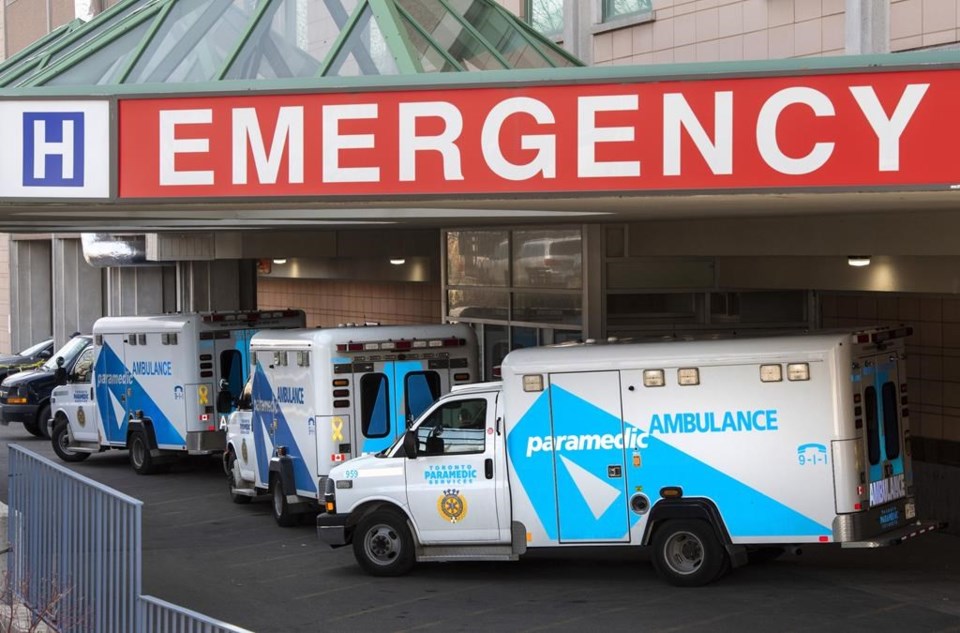Ontario has granted a three-month funding extension for doctors to provide care in virtual emergency departments, but the last-minute deal came too late for some hospitals to reverse plans to close online ERs.
The provincial funding had been set to run out after Friday, and several hospitals said that meant they had to shut their virtual emergency rooms.
The deal reached Wednesday between the province and the Ontario Medical Association extends funding until June 30, said Health Minister Sylvia Jones.
"We will continue to work with the OMA to ensure that care is available to Ontarians where and when they need it," Jones wrote in a statement to The Canadian Press.
The government will "assess what is needed across the health-care system" for a long-term plan on virtual ERs, she said.
About a dozen hospitals across the province launched virtual ERs during the pandemic in an effort to divert patients from jammed waiting rooms.
The Unity Health Toronto hospital network, which partnered with two other hospital systems on a virtual ER, said the last-minute funding extension doesn't change its planned wind-down of the online service.
Spokeswoman Jennifer Stranges said the virtual department was "key in ensuring access and continuity of health services" during the pandemic.
"We're now looking at how as an organization we use virtual care to provide access to health services to our patients and community," she said.
Michael Garron Hospital also said it would still be ending its "innovative" virtual ER program on Friday.
Dr. Kyle Vojdani, the medical director of the hospital's emergency department, said their virtual ER was launched in March 2021 in an effort to address the trend of patients avoiding the hospital due to COVID-19.
The program saw more than 4,500 patients visit virtually over the past two years, he said. Nearly 75 per cent of those patients did not need to go to the physical emergency department.
"The government of Ontario is promoting a shift in care delivery model and encouraging Ontarians to use Health811, previously known as Health Connect Ontario and Telehealth Ontario, to access virtual care where appropriate," Vojdani wrote in an email.
The University Health Network – the largest hospital system in the country – had partnered with Unity Health and Sunnybrook Health Sciences Centre to operate a program called the Toronto's Virtual Emergency Department.
While Unity Health was ending its partnership in the program, the CEO of the University Health Network said last week that his hospital system would keep offering a virtual ER, regardless of whether provincial funding came through or not.
"We'll continue to work with government to demonstrate to them why this is a worthwhile investment and how it helps one of their – and our first – priorities: not overwhelming emergency departments," Kevin Smith said.
"It's been a very successful endeavour – about 85 per cent of people we see virtually don't need to come to hospital."
That equates to more than 3,000 patients who avoided an unnecessary trip to the emergency room.
Sunnybrook Health Sciences Centre will continue its partnership in the joint program until the end of June, it said.
"Plans for after that date are still being determined," said spokesperson Idella Sturino. "We are glad to be able to continue offering this trusted resource for patients and their families at this time."
The Hospital for Sick Children in Toronto also said its virtual ER program will continue.
Hospitals across the province have grappled with extended periods of overwhelmed emergency departments over the past three years. Many emergency departments run close to 100 per cent capacity during normal times and struggle when surges hit.
Some were overrun with COVID-19 patients while others dealt with record numbers of viral respiratory patients, particularly pediatric hospitals last fall.
Numerous emergency departments, especially those in smaller or rural communities, closed for hours, days or even weeks at a time last year. Hospital officials said those closures were primarily due to severe staffing shortages, particularly nurses.
The opposition called on the government Thursday to make funding for virtual ERs permanent.
"It's important that the government is willing to make a change and realize when they made bad policy," said NDP Leader Marit Stiles.
"I would like them to extend it beyond the three months."
Green Party Leader Mike Schreiner said the virtual ER innovation is exactly what the health-care system needs.
"Hopefully the government woke up and realized they made a mistake when they were going to cut the virtual ER program," he said. "I'm hoping this is a first step to making that program permanent."
The province has been letting several health-care programs tied to temporary pandemic funding wind down. The government's three paid sick days will end Friday, as will a program that allowed patients without the province's health insurance to receive care.
This report by The Canadian Press was first published March 30, 2023.
Liam Casey, The Canadian Press

